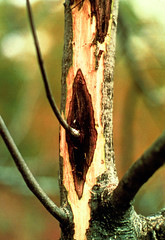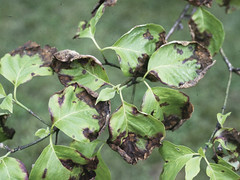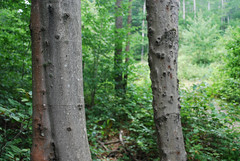Diseases
Learn More
Other Websites
Bacteria and fungi (together with insects) are an important part of nature’s grand recycling program, converting dead plant and animal tissue to nutrients that can be used by living plants. But non-native bacterial, viral and fungal pathogens have caused diseases that have wiped out some plant species in Rock Creek Park and threaten others.
Plant diseases typically infect some species and not others, which is why many diseases are called by the name of the plants they most profoundly impact.
Not all of the diseases listed below have reached Rock Creek Park yet, but they are on course to do so! Below, diseases marked "potential" are threats to Rock Creek Park but have not yet been confirmed there.
Explore this page:
Where Do They Come From?
Many of the most threatening plant diseases spreading in the U.S. today were brought there on plants or wood products from around the world. (In the same way, some of the most threatening plant diseases spreading in Asia today were brought there from the U.S.!) Ecobit: Why Are Catastrophic Plant Diseases Usually Non-Native?
U.S. agencies are working to stop or slow their spread through the U.S., sometimes by quarantining plant products and soils from infected states or counties.
Plant Diseases Threatening Rock Creek Park
Chestnut Blight
 A pathogenic fungus causes chestnut blight, a lethal infection that has devastated the American chestnut tree (Castanea dentata) across its range in the eastern United States.
A pathogenic fungus causes chestnut blight, a lethal infection that has devastated the American chestnut tree (Castanea dentata) across its range in the eastern United States.
Photographer: Flickr user Vicky SommaIn the first several decades of the 1900s, an introduced fungus called chestnut blight (Cryphonectria parasitica) killed virtually all of the American chestnut trees in the forests of the eastern United States, including those in Rock Creek Park. Some healthy trees were cut down to prevent the spread, too.
Because chestnut was a major canopy tree, some of Rock Creek Park’s hillside forests looked vastly different when the park was established in 1890 than they do today.
The roots of the American chestnut continue to send up sprouts on some hillsides in the park. Unfortunately, it's likely that all of these sprouts will become infected and die back before reaching maturity. Look for a pencil-thick, spindly sapling (little to no branching), sometimes waist high or more. The leaves are similar to the chestnut oak, but with much more sharply pointed teeth. The sprout you see today probably comes from a seed that first germinated a century ago or more.
Butternut Canker
 Butternut canker is a lethal fungal infection of butternut trees (Juglans cinerea).
Butternut canker is a lethal fungal infection of butternut trees (Juglans cinerea).
Photographer: Mike Ostry, US Forest Service.All across the U.S., butternut canker (Sirococcus clavigignenti-juglandacearum) is making the butternut tree, which was never very common, especially hard to find.
Butternut, also called white walnut, is at the edge of its natural range in Rock Creek Park. Very few butternut trees remain in Rock Creek Park. Those that do are largely infected, and not expected to survive.
Dogwood Anthracnose
 Dogwood anthracnose (Discula destructiva) leaf blotch.
Dogwood anthracnose (Discula destructiva) leaf blotch.
Photographer: Mary Ann Hansen, Virginia Polytechnic Institute and State University, Bugwood.org. Dogwood anthracnose (Discula destructiva) has been attacking flowering dogwoods in the U.S. since the mid-1970s.
The gorgeous white blooms of flowering dogwood trees grace virtually all of Rock Creek’s hillside natural communities in spring. In the fall, many birds eat its berries. Quite a few flowering dogwoods in Rock Creek Park have been infected by anthracnose. Some trees seem to be resistant, while others are dead or in decline. Currently the park is not actively managing against this disease.
Dutch Elm Disease (potential)
 Evidence of Dutch elm disease (Ophiostoma ulmi) on an American elm (Ulnus americana).
Evidence of Dutch elm disease (Ophiostoma ulmi) on an American elm (Ulnus americana).
Photographer: Joseph O’ Brien, USDA Forest Service, Bugwood.org. Dutch elm disease (Ophistoma ulmi) can infect all of our native elm species, and infected trees usually die.
The American elm (highly susceptible) has historically been part of Rock Creek Park’s Tuliptree Small-Stream Floodplain Forest. It doesn’t mind an occasional flooding in exchange for the rich silt and sand Rock Creek deposits when it overflows its banks. Well-rooted trees like the American elm play a significant role helping hold soil in place in Rock Creek’s floodplains. You can see a large American elm near Boundary Bridge in the north of the park.
Slippery elm is also susceptible. It's a typical understory tree in damp, low-lying forests like the Basic Mesic Hardwood Forest and the Tuliptree Small-Stream Floodplain Forest.
Elm Yellows / Elm Phloem Necrosis (potential)
 Elm yellows or elm phloem necrosis is a lethal disease affecting elm trees (Ulmus spp.) in the eastern U.S. and Canada.
Elm yellows or elm phloem necrosis is a lethal disease affecting elm trees (Ulmus spp.) in the eastern U.S. and Canada.
Photographer: Flickr user William Yurasko.As if one elm disease weren’t enough, there is another, newer threat. Elm yellows is caused by a bacteria that is spread by an insect called the leaf hopper. Elm yellows has not yet appeared in Rock Creek Park.
Beech Bark Disease (potential)
 Beech bark disease causes lesions in the bark of American beech trees (Fagus grandifolia).
Beech bark disease causes lesions in the bark of American beech trees (Fagus grandifolia).
Photographer: Flickr user Eli Sagor.Beech bark disease (Nectria coccinea var. faginata or Nectria galligena) can kill large American beech trees. It has been spreading throughout the eastern United States, and has been found in Virginia and Maryland forests.1
American beech plays an important role for wildlife in the hillside forests at Rock Creek Park, providing food—beechnuts—and den habitat for numerous animals. It is the most abundant tree in the park. Beech bark disease would therefore seriously impact the natural communities here.
Sudden Oak Death (potential)
A relative newcomer to the park’s list of management concerns is a disease called sudden oak death (Phytophthora ramorum).
Though this disease is not yet known from Rock Creek Park, park management is on the lookout for it. Laboratory tests show northern red oak and southern red oak to be highly susceptible to the disease. The disease prefers cool, moist air, so it is a lesser concern in the park's driest ridgetop communities.
You Can Make a Difference!
The National Park Service keeps a vigilant watch, and asks visitors to do the same, so that suspected disease outbreaks can be identified early and curbed where possible. Ecobit: An Extra Set of Eyes By being observant when you're visiting Rock Creek Park and sharing what you see with park staff, you can help keep its natural communities healthy. Thank you!
- 1. . 2008. Beech Bark Disease. Accessed 2018


